Coconut macaroons are a golden, buttery dream. They are crispy on the outside and chewy inside. These homemade treats are easy to make with just 6 simple ingredients.
They take only 35 minutes to make, from start to finish. You can enjoy them plain or dipped in chocolate. They are loved for their sweet coconut flavor and soft texture.
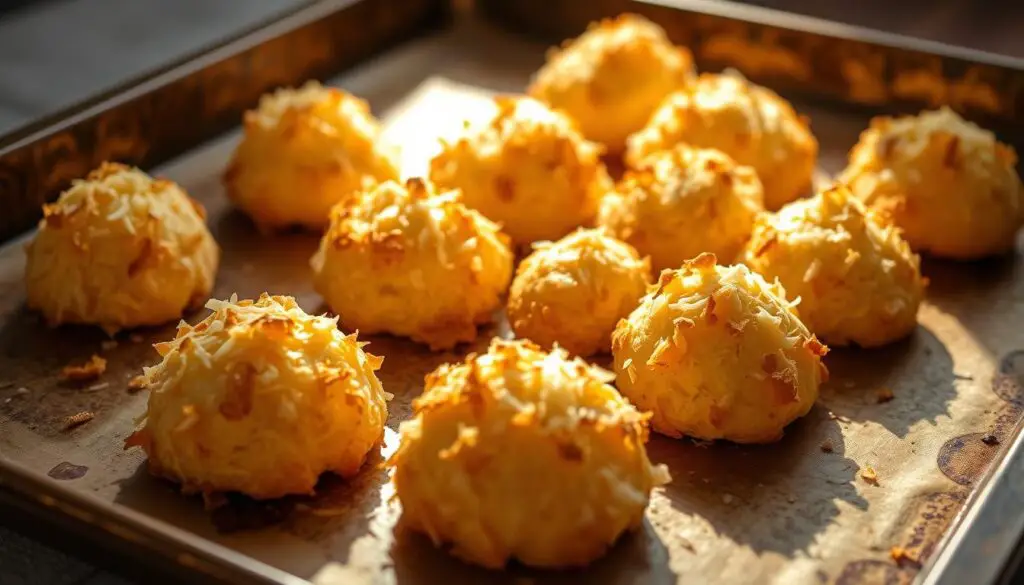
These treats are baked to perfection at 325°F for 20 minutes. They are as easy to make as they are delicious. Whether you store them for weeks or serve them fresh, they are the ultimate comfort food.
Their crisp edges and gooey middle make them hard to resist. No baking skills are needed. Try this classic recipe and enjoy the taste of freshly made coconut perfection!
What Makes Coconut Macaroons So Special
Coconut macaroons are unique in the cookie world. They have a special texture and taste. These treats are simple yet indulgent, making them a classic favorite. Let’s explore what truly sets them apart.
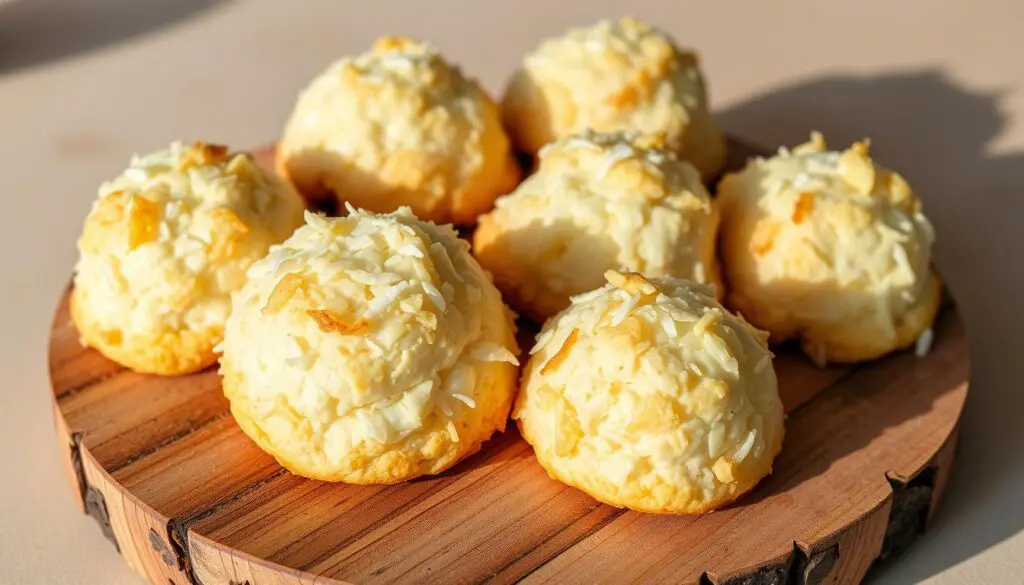
The Rich History of Coconut Macaroons
Coconut macaroons started in Jewish communities. They became a Passover staple because they didn’t have eggs. Over time, they evolved into the best coconut macaroons we know today. In France, they’re called “Rochers Coco,” often shaped like small pyramids and sometimes infused with apple compote for moisture.
Difference Between Macaroons and Macarons
- Coconut macaroons use shredded coconut, egg whites, and sugar.
- French macarons are meringue-based sandwich cookies with almond flour.
- Macaroons have a chewy texture; macarons are crisp on the outside, soft inside.
Why These Chewy Treats Are Universally Loved
With their chewy coconut macaroons texture, they mimic the iconic center of candy bars like Almond Joy. The perfect recipe balances 125g shredded coconut, 90g sugar, and 75g egg whites. Adding honey locks in moisture, ensuring they stay soft for days. Their simplicity and adaptability make them a hit at parties or as gifts.
Essential Ingredients for Perfect Coconut Macaroons
Learning about coconut macaroon ingredients is key to making delicious coconut cookies. Start with high-quality sweetened flaked coconut, like Baker’s Angel Flake, for a consistent texture. Add sweetened condensed milk for moisture and sweetness, and egg whites to hold it all together. Vanilla extract adds a warm touch, and a pinch of salt balances the flavors.
Optional semi-sweet chocolate chips or a drizzle can add a special touch.
- Sweetened flaked coconut: The star ingredient, choose brands like Baker’s Angel Flake for uniform texture.
- Sweetened condensed milk: Forms the sticky base that holds the cookies together.
- Egg whites: Create structure; 5–6 large eggs yield the right volume.
- Vanilla extract: Enhances without overpowering coconut flavor.
- Salt: Brings out natural sweetness in the mixture.
For substitutions, unsweetened coconut can be used but needs more egg whites and sugar. Toasting coconut lightly at 350°F for 5 minutes adds a nutty flavor. Avoid overmixing to keep the batter light. These coconut macaroon ingredients come together to make golden treats in 15–20 minutes at 350°F. Store them in airtight containers for up to 3 days, or freeze for longer.
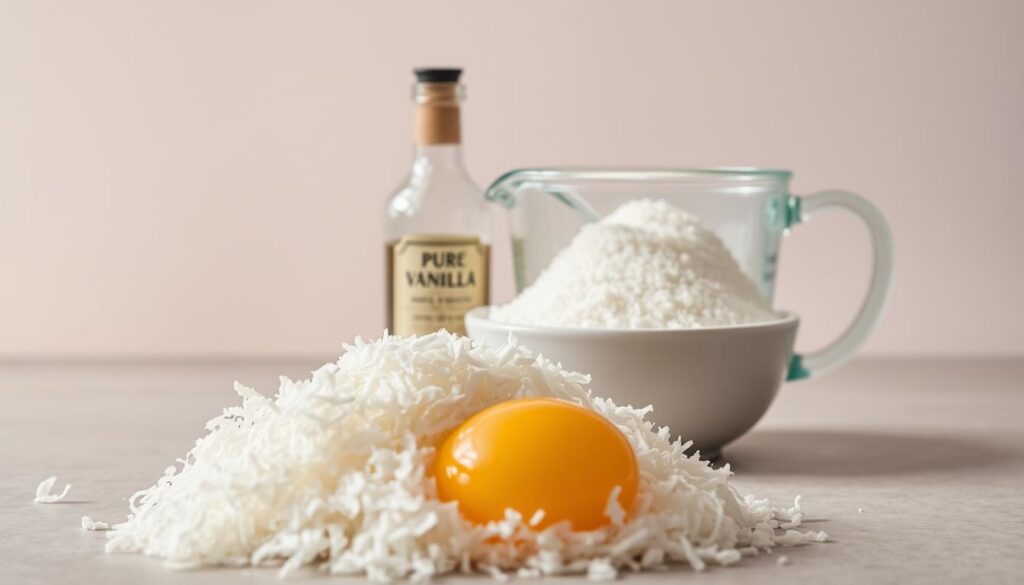
Using the right ingredients makes a big difference. Stick to the right ratios, like 2 cups of coconut and ½ teaspoon vanilla, for a chewy, sweet cookie. Now you’re all set to start mixing!
Equipment You’ll Need for Baking Success
To make a perfect coconut macaroon dessert, you need the right tools. Even with basic equipment, you can get great results. Here’s what you’ll need:
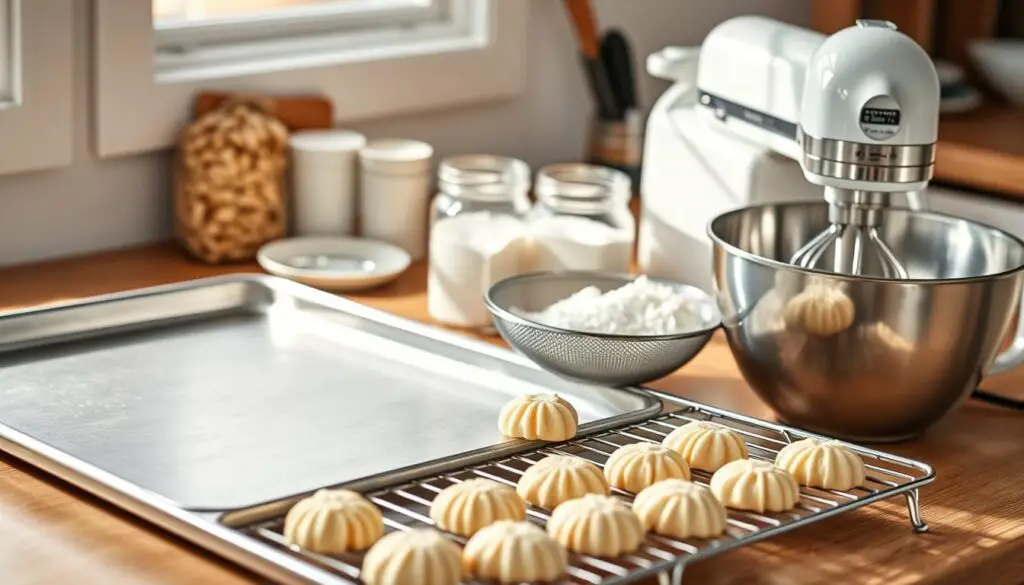
Basic Tools Every Baker Should Have
- Mixing bowls: Use metal bowls to avoid grease residue.
- Measuring cups: Opt for a set with 1/4 to 1-cup sizes plus a food scale for accuracy.
- Baking sheets: Two aluminum sheets ensure you can swap them mid-bake for even results.
- Parchment paper or silicone mats: Essential for preventing sticking—never use wax paper!
- Measuring spoons: Keep a full set nearby for precise sugar and spice amounts.
Optional Equipment for Professional Results
A food processor can finely chop coconut for a coconut macaroon dessert that holds its shape. A medium cookie scoop (1.5 tablespoons) ensures uniform portions. For large batches, a stand mixer speeds up mixing stiff egg whites. Pro tip: Two silicone mats (11×16 inches) simplify swapping pans without cleanup pauses.
Even with just basics, you’ll master this easy coconut macaroon recipe. A cooling rack and spatula complete your setup. Remember: quality tools boost consistency, but creativity and practice matter most. Start simple, and let your kitchen grow with your baking passion!
Step-by-Step: Creating Your Coconut Macaroons
Ready to make delicious homemade coconut macaroons? Follow this easy recipe step by step. These chewy treats take about 35 minutes to make. With just a mixer and patience, you’ll create golden-brown morsels everyone will love.
Preparing Your Ingredients
First, make sure egg whites are at room temperature. This helps them whip properly. Use a dry measuring cup to measure 14 oz of Baker’s Angel Flake shredded coconut. If using a cookie scoop, test it with 1.5 tablespoons of mixture to ensure even portions. Set up parchment-lined baking sheets and preheat your oven to 325°F.
Mixing the Perfect Batter
Beat egg whites with a mixer on medium-high until foamy (about 1 minute). Add ½ cup sugar, vanilla, and almond extract, continuing until sugar dissolves but not stiff. Fold in coconut gently to keep airiness. Overmixing here leads to dry centers.
Shaping Techniques for Beautiful Macaroons
Use a #20 cookie scoop or spoon to form 1.5 Tbsp portions. Roll dough into balls and place them 2 inches apart on sheets. Press lightly to flatten tops slightly—this prevents spreading. For uniform results, bake one sheet at a time if using multiple pans.
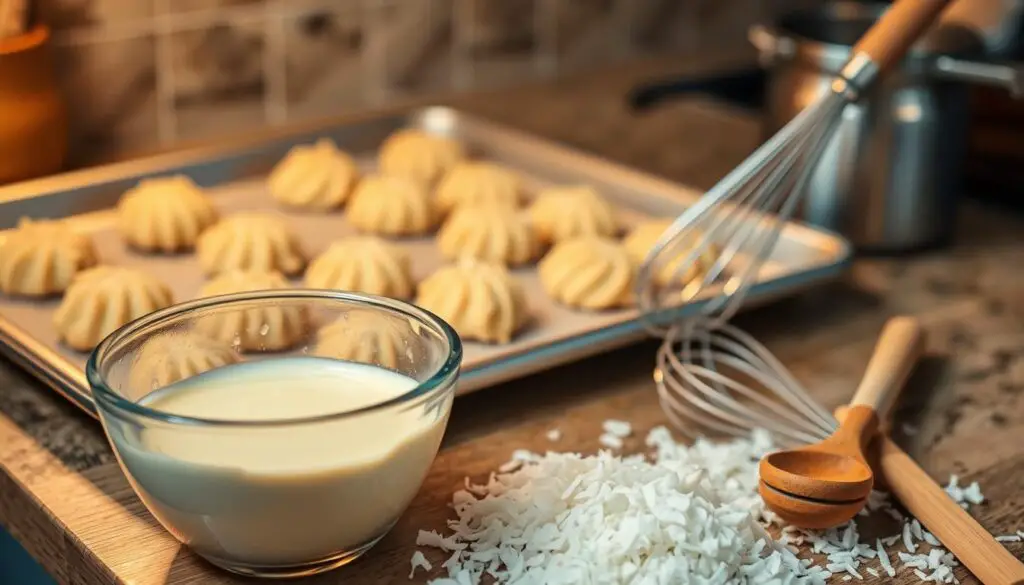
Baking Times and Temperature Guidelines
Slide trays into a 325°F oven. Bake for 20-25 minutes until edges brown lightly. Rotate pans halfway through for even browning. Let macaroons cool on pans for 5 minutes before transferring to a rack. Tip: Overbaking causes dryness—check at 18 minutes if edges are browning quickly. Store cooled macaroons in an airtight container at room temperature for up to 4 days or freeze for 3 months.
The Secret to Achieving That Perfect Chewy Texture
Getting the chewy texture of the best coconut macaroons is all about the right steps. It’s about finding the perfect mix of ingredients and techniques. Here’s what you need to know:
- Beat egg whites just until foamy—overmixing stiffens batter, leading to dry results.
- Use sweetened shredded coconut for natural moisture and sweetness.
- Bake at 325°F (160°C) for exactly 20 minutes. Overbaking turns them dry and crumbly.
“Bake for only a precise 20 minutes, or until lightly browned. Over-baking will dry out your coconut macaroons.”
Letting the batter rest for 10 minutes before baking is crucial. It helps the ingredients blend well. Use chilled egg whites for chewiness, not room-temperature ones.
After baking, cool the macaroons on the pan for 5 minutes. Then, transfer them to a rack. This keeps them moist and chewy.
Patience is essential. Rushing the cooling or skipping the sweetened condensed milk can ruin the texture. Follow the recipe closely for chewy macaroons that stay soft for days.
Troubleshooting Common Coconut Macaroon Problems
Even the most experienced bakers can run into problems when making coconut macaroons or cookies. Let’s look at the top three issues to help your batch turn out perfectly every time.
“Many recipes call for it but, in my experience, they all have the same problem: too much liquid, which causes the sweet batter to pool around the edges of the macaroons and burn in the oven.”
Why Are My Macaroons Spreading Too Much?
Too moist batter is the main problem. Coconut macaroons spread when there’s too much liquid. Try these fixes:
- Use ⅞ cup (not a full can) of condensed milk.
- Chop coconut finely but not too fine to avoid sogginess.
- Beat egg whites until soft peaks form—overbeating makes mixtures unstable.
Fixing Dry or Crumbly Macaroons
These problems often come from overbaking or using dry coconut. Check these tips:
- Bake at 325°F for 20–25 minutes—no longer.
- Test coconut moisture: add 1–2 tsp water if too dry.
- Use unsweetened coconut; sweetened versions add extra sugar and dryness.
SSolutions for Overly Sweet Results
Too much sugar can overpower the coconut cookies’ flavors. Try these adjustments:
- Reduce condensed milk by 2 tbsp if using sweetened coconut.
- Add ¼ tsp salt to balance flavor.
- Top with dark chocolate drizzle for a rich contrast.
| Issue | Fix | Keyword Tip |
|---|---|---|
| Spreading | Measure milk precisely | Use a kitchen scale |
| Dry texture | Check coconut moisture | Store coconut in a sealed bag |
| Too sweet | Adjust sugar ratios | Taste batter before baking |
With these tweaks, even tricky batches become golden. Happy baking!
Delicious Variations to Try
Make your coconut macaroons special with these creative ideas. With over 1,300 five-star reviews, these treats are best when you add your own twist. Here are three ways to make your batch stand out:
Chocolate-Dipped Coconut Macaroons
- Melt 4 ounces of chocolate using a microwave or double boiler.
- Dip cooled macaroons halfway into the chocolate, then place back on a parchment-lined tray.
- Drizzle extra chocolate on top for a gourmet touch.
Try dark, milk, or white chocolate for different flavor profiles.
Almond Joy-Inspired Macaroons
- Follow the base recipe but add 1/2 cup flaked coconut and 1/2 cup sweetened condensed milk.
- After baking, dip bottoms in melted chocolate and press a whole almond on top while still wet.
Perfect for candy bar fans, this variation blends nostalgia and homemade charm.
Fruity Flavor Additions
- Pina Colada Twist: Stir in dried pineapple and salted macadamia nuts.
- Citrus Zest: Add 1 tsp lemon or orange zest to the batter.
- Tropical Mix: Fold in 1/2 cup dried mango or papaya for a tangy kick.
| Nutrition Facts | Per Cookie |
|---|---|
| Calories | 46 |
| Carbohydrates | 8g |
| Protein | 1g |
| Fat | 1g |
| Sugar | 8g |
Try adding chocolate chips or nuts (up to 1½ cups) for a fresh twist. Whether you drizzle, dip, or add fruit, these ideas show that the best coconut macaroons are all about creativity.
Making Gluten-Free Coconut Macaroons
Coconut macaroons are naturally gluten-free, making them safe for those avoiding gluten. To keep your gluten-free coconut macaroons gluten-free, use ingredients that are certified gluten-free. Always check labels for hidden gluten in vanilla extract or sweetened coconut.
- Use unsweetened shredded coconut (2 ¼ cups) and verify it’s processed in a gluten-free facility.
- Substitute any added flour with almond flour (2 tablespoons) or gluten-free blends.
- Opt for vanilla bean paste or gluten-free vanilla extract to avoid additives.
These coconut macaroons need only 5 ingredients and 40 minutes to make. Bake at 350°F for 18-20 minutes, until they’re golden and firm. Let them cool completely on the pan before serving or storing. For long-term storage, freeze in airtight containers for up to 3 months.
| Per Cookie | Value |
|---|---|
| Calories | 88 |
| Carbohydrates | 11g |
| Protein | 1g |
| Fat | 5g |
| Sugar | 10g |
For a sugar-free version, replace 150g sugar with monkfruit sweetener. Always let the mix rest 30-60 minutes before baking. Enjoy these gluten-free coconut macaroons as a guilt-free dessert or snack!
Vegan Options for Coconut Macaroon Lovers
Want a vegan coconut macaroon recipe that’s just as tasty as the original? No eggs or dairy? Easy changes make these treats into coconut cookies that everyone will enjoy. Let’s see how to keep them delicious and soft.
Egg Replacements That Actually Work
- Aquafaba: Use 3 tablespoons (45g) of chickpea liquid per egg. Whip until stiff peaks form—takes 3–6 minutes.
- Commercial replacers: Brands like Ener-G Egg Replacer work well when mixed as directed.
- Flax egg: Mix 1 tbsp ground flax + 3 tbsp water. Let sit 5 minutes to gelatinize.
- Coconut cream: ¼ cup adds richness but may soften texture slightly.
Plant-Based Sweetener Options
Try these sweetener swaps:
- Coconut condensed milk: Use store-bought or blend coconut milk with maple syrup.
- Date paste: Blend pitted dates with water for a natural sweetener.
- Maple/agave syrup: Reduce by ¼ to avoid soggy dough; adjust baking time by 2–3 minutes.
| Per Macaroon (Vegan Version) | Nutrition Facts |
|---|---|
| Calories | 129 |
| Carbs | 13g |
| Protein | 2g |
| Fat | 9g (7g saturated) |
| Sugar | 9g |
| Storage: | Up to 5 days at room temp or 3 months frozen. |
Try these changes to make a coconut cookies recipe you’ll love. Share your recipes and tag us. We love seeing your creations!
Best Ways to Store Your Homemade Coconut Macaroons
Storing homemade coconut macaroons right keeps them fresh for parties or leftovers. Follow these tips to keep their chewy texture and sweet taste.
“Coconut macaroons can be stored in a ziplock bag in the freezer for several months.” – USDA food storage guidelines
Counter, Refrigerator, or Freezer?
Choose your storage method based on when you’ll eat them:
- Counter: Store in an airtight container for up to 3 days. Perfect for weekend events.
- Refrigerator: Lasts 1 week in a sealed container. Texture gets slightly firm but stays moist.
- Freezer: Store in ziplock bags for up to 3 months. Freeze fully cooled macaroons to avoid ice crystals.
How to Keep Macaroons Fresh for Special Occasions
Follow these steps for perfect coconut macaroon dessert at gatherings:
- Layer macaroons with parchment paper in airtight containers to prevent sticking.
- Freeze uncooked dough balls for up to 3 days before baking for last-minute prep.
- Thaw frozen macaroons in the fridge overnight. Let them sit at room temperature 30 minutes before serving.
Reheat frozen macaroons at 300°F for 5 minutes to restore crisp edges. Always label containers with dates to track freshness. These steps ensure your homemade coconut macaroons stay moist and delicious long after baking day!
Serving Suggestions to Impress Your Guests
Make your homemade coconut macaroons a hit with these easy yet stylish ideas. Start by placing them on a wooden board with fresh berries, dark chocolate truffles, or small shortbread cookies. A sleek slate tile or glass platter adds a modern touch, showing off their golden-brown color.
- Pair coconut cookies with a drizzle of raspberry coulis or a sprinkle of sea salt atop chocolate-dipped varieties.
- For holidays, nestle them in festive tins lined with tissue paper. Tiered stands work well for baby showers or afternoon teas.
- Set up a dessert bar offering toppings like crushed pistachios, caramel, or coconut flakes for a hands-on experience.
Place macaroons on a bed of edible flowers or mint sprigs for an extra touch of elegance. A light dusting of powdered sugar and a hint of citrus zest makes them even sweeter. For gatherings, serve them with espresso or spiced tea to balance their coconut flavor. These coconut cookies are perfect as the star of any dessert table—no complicated techniques needed!
Pairing Coconut Macaroons with Beverages
Find out how the perfect drink can turn a basic coconut macaroon dessert into a memorable experience. The right drink can make the tropical sweetness of coconut macaroons even better. At a 2018 Galentines Day event, Bake No Fake’s creations were paired with cocktails like the Amor Amaro Sour (made with Amaro delle Sirene). This showed how bold flavors can really bring out the best in these treats.
Coffee and Tea Combinations
Start your day off right with:
- Medium-roast coffee to balance plain coconut macaroons.
- Earl Grey tea’s bergamot notes to contrast with sweet bites.
- Sparkling water with lime for a light, refreshing option.
Wine and Spirit Pairings
| Beverage | Pairing Idea |
|---|---|
| Late-Harvest Riesling | Cuts through sweetness with bright acidity. |
| Coconut Rum Cocktail | Enhances tropical notes in chocolate-dipped macaroons. |
| Port Wine | Matches dark chocolate-topped coconut macaroons. |
| Amor Amaro Sour | Amaro delle Sirene’s bitterness balances coconut’s richness. |
Hot chocolate pairs luxuriously with plain coconut macaroons. Dry sherry offers a sophisticated contrast. Let your curiosity lead you—try new things to make every bite and sip special. The goal is to find harmony: let flavors either echo or contrast your treat’s creamy sweetness.
Gifting Your Homemade Coconut Macaroons
Sharing homemade coconut macaroons as gifts shows your creativity and care. They are perfect for birthdays, holidays, or just to make someone’s day brighter. Choose packaging that looks good and is practical.
- Bakery boxes lined with parchment paper for a professional look
- Cut-glass jars filled with layers of cookies and tissue paper
- Cellophane bags tied with twine or ribbon for a rustic touch
- Decorative tins for a reusable and eco-friendly option
Make it personal with handwritten labels. Note the easy coconut macaroon recipe or how to store them. Attach a card with the recipe or a note like, “Bake more joy with this simple recipe!”
Pair macaroons with items like coffee beans, dessert wine, or tea in gift baskets. A note on how to enjoy them, like with coffee or spiced chai, adds a special touch.
Gifts don’t have to be perfect. Homemade treats with imperfections show you care. They are a sweet gesture that anyone will love.
Time to Start Baking Your Own Irresistible Coconut Treats
Start your journey to perfect coconut macaroons now. This recipe has been a favorite since 2006. It only needs five ingredients: sweetened shredded coconut, an egg, melted butter, vanilla, and salt.
It’s easy for anyone to make. You can mix, bake, and enjoy these treats in under an hour. No chilling is required.
These macaroons have a crisp outside and a soft inside. Bake them at 375°F for 14 minutes. You can also add chocolate or fruit to make them your own.
Since 2016, this recipe has become a hit across the country. It’s a go-to for many bakers.
Share your macaroons with loved ones or give them as gifts. You can even use oats instead of coconut for a healthier option. These cookies are great with coffee or dessert wines. They celebrate the joy of simple, indulgent baking.
FAQ
What makes coconut macaroons different from traditional cookies?
Coconut macaroons are special because of their chewy inside and crispy outside. They’re mostly made from coconut, unlike regular cookies that use flour and butter.
What is the best sweetened coconut to use for macaroons?
Baker’s Angel Flake sweetened coconut is the top choice. It adds the perfect chewiness to your macaroons.
Can I use unsweetened coconut in my coconut macaroons?
You can use unsweetened coconut, but you might need to add more sugar or sweetened condensed milk. This will help get the right taste and texture.
How can I ensure my macaroons stay chewy?
For chewy macaroons, beat the egg whites until just foamy. Use sweetened coconut for moisture. And bake them for the exact time the recipe says.
What are some easy variations I can try with coconut macaroons?
Try dipping them in chocolate, making Almond Joy treats, or adding dried cranberries or citrus zest. These are fun ways to change up the classic coconut macaroon.
Are coconut macaroons gluten-free?
Yes! Coconut macaroons are naturally gluten-free. Just make sure to check the labels of sweetened condensed milk and coconut for any hidden gluten.
What are good egg replacements for vegan coconut macaroons?
For vegan macaroons, use aquafaba (chickpea liquid) as an egg white substitute. You can also try commercial egg replacers or flax eggs.
How can I store my homemade coconut macaroons for maximum freshness?
Keep your macaroons in an airtight container at room temperature for up to 3 days. Store them in the fridge for about a week or freeze for up to 3 months.
What drinks pair well with coconut macaroons?
Enjoy them with rich coffee or coconut tea. For wine, try a sweet Riesling or Moscato d’Asti. Chocolate-dipped macaroons pair well with port or amaretto.
How can I present my coconut macaroons as gifts?
Package them in decorative tins, mason jars, or bakery boxes. Add a personal touch with a recipe card or festive label.